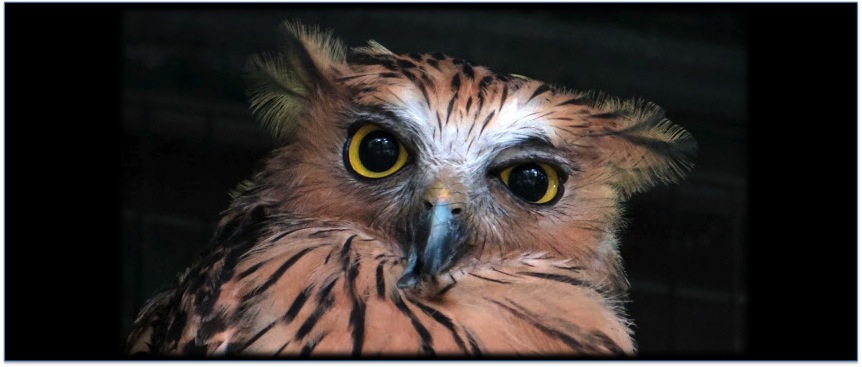 |
| Ketupa ketupu (Horsefield, 1821) (Adapted from photo by: Annie Irving Permission granted) |
Table of Contents
Synonyms: Bubo ketupu (Christidis and Boles, 2008)
Etymology
The name ketupu as in its Latin bionomial name, could have been derived from its old Javanese name, kutupu-kutupuk, which was also based on the owl's calls. [1]
Buffy Fish Owl, one of the more common names of the Ketupa ketupu, is so named because of the buffy colouration of its body in relation to the other Fish Owls, being a more yellow-beige colour than the other 4 species. It is also sometimes referred to as Java/Malay/Malaysian Fish Owl, in reference to the localities it is found in, more common in the Indonesian island of Java and in the Malay Peninsula.
Taxonomy & Systematics
Original description
The original description of this species has been recognised to be by Thomas Horsfield in 1821, in the publication Transactions of the Linnean Society of London under the section XIV Systematic Arrangement and Description of Birds from the Island of Java. [2]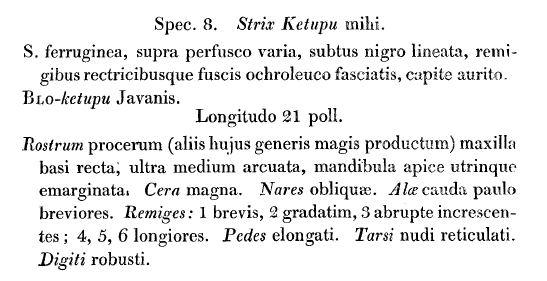 |
Species 8. Strix Ketupu S. rusty, above various perfusca, under black-lined, oar-brown tiles [retricibusque ochroleuco] bundled, eared head. BLO-ketupu Javanese Length 21 [poll] Rostrum (beak) high/extended (the more, the product of this kind to others) to lower jaw baseline, beyond the middle of the arch, apex of jaw on both sides. Wax great. Nose narrow. Wings little tail. Feather: 1. short 2. gradual 3. abruptly growing 4, 5, 6 are longer. Feet elongate. Tarsi (ankle) naked, reticulated. Toes strong |
| Original description of Ketupa ketupu (in Latin) |
English translation (using Google Translate and wikitionary) |
Type Specimen
Type specimen is located in British Museum (Natural History) [3]Changes in Genus
Though originally identified to be part of the Strix genus by Horsfield, this species was later relegated to the Ketupa genus instead by Lesson (1830), together with 3 other Fish Owl species found in Asia, K. blakistoni, K. flavipes and K. zeylonensis, consisting 4 species in total, based on their distribution and their specialised adaptations to hunting of fish and other aquatic organisms.However, there have been attempts to revise the status of Ketupa as a genus using phylogenetics, suggesting that they should be under the genus Bubo instead. A phylogenetic study of Owl species using the DNA-sequences of mitochondrial cytochrome-b gene has been done by Wink & Heidrich (1999) [4] , this showed the close relation of the Ketupa genus to three other Bubo species B. lacteus, B. nipalensis and B. sumatrana, with a distance of 10.2% between zeylonensis and nipalensis and 9.2% between zeylonensis and sumatrana [5] . A further study using nuclear marker LDHb intron DNA, further corroborated with the findings of the first study (Wink, Sauer-Gürth & Fuchs, 2004) [6] . The following phylogenetic tree is the latest findings found in König et. al (2008) [7] , based on the combined dataset of mitochondrial cytochrome-b (Will & Heidrich, 1999) [4] and the RAG-1 sequences, to show that ketupu, together with zeylonensis are nested in the Bubo genus.
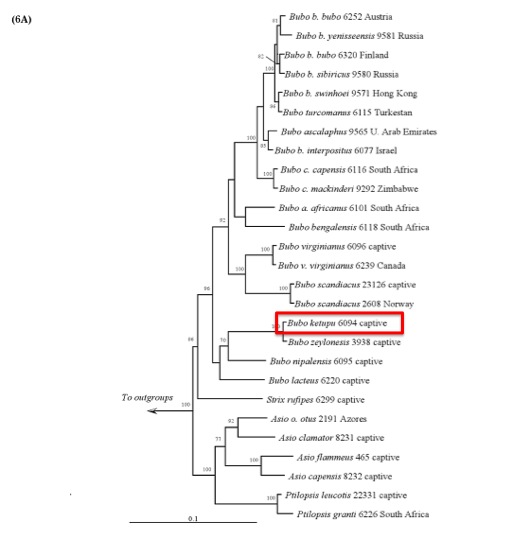 |
| Maximum likelihood bootstrap phylogram based on a combined dataset of cytochrome-b and RAG-1 sequences; showing Ketupa ketupu nested in the Bubo genus. (König et al, 2008) |
Subspecies
Four subspecies of Ketupa ketupu have been listed in König et al (1999) [8], mainly differentiating in their localities| K. k. ketupu (Horsfield, 1821) |
Malay Peninsula, Riau Archipelago, Sumatra, Bangka. Belitung, Java, Bali, Borneo (except portion occupied by K. k. pageli) |
| K. k. aagaardi (Neumann, 1935) |
S Burma, South, East and peninsular Thailand and Annam. Sim to nominate ketupu from Java, but much paler, esp below (wing 315-345mm) |
| K. k. pageli (Neumann, 1936) |
Eastern coast of Sarawak, N Borneo Sim to nominate ketupu from Java, but far more reddish/brick-red. (wing 310-333mm) |
| K. k. minor (Büttikofer, 1896) |
Syn: buettikoferi Confined to Island of Nias. Off west coast of Sumatra. Smaller race. (Wing 295-300mm) |
Description
For the general anatomy of owls, click hereDescriptions are summarised from (König et. al, 1999) [8] with additional information from owlpages.com [9]
Measurements
Length: 40-48cm.Wing length: 295-390mm.
Tail length: 160-181mm.
Weight: 1028-2100g.
Anatomy
| Face |
Facial disc: |
Ill-defined |
| Ear tufts: |
Distinct sideward directed (45 degree angle) |
|
| Eyebrows: |
White |
|
| Eyes: |
Iris, bright yellow. Eyelids black |
|
| Bill: |
Black or greyish-black. Cere greyish-white, tip pale yellowish horn |
|
| Feathered body parts |
Upper parts: |
Rich brown |
| Head, neck: |
Same as upperparts, feathers without white tips |
|
| Back, mantle: |
Blackish-brown, broadly margined with buff and with pale rufous or whitish spots near the tips |
|
| Wings, tail: |
Broadly barred yellowish and dark brown |
|
| Scapular: |
Outer webs fulvous, does not form pale row across the shoulder |
|
| Wing coverts: |
same as the back, much larger pale spots. |
|
| Primaries, secondaries: |
Dark brown, banded with whitish or fulvous. |
|
| Tail |
Dark brown, whitish tips and 3 or 4 buffish-white bars. |
|
| Underparts: |
Yellowish-brown, rich buff or fulvous |
|
| Flanks: |
Unstreaked |
|
| Legs |
Tibia: |
Unstreaked |
| Tarsi: |
Long, relatively unfeathered, yellowish grey |
|
| Toes: |
Greyish or pale brown, lighter soles |
|
| Claws: |
Darker to blackish-brown |
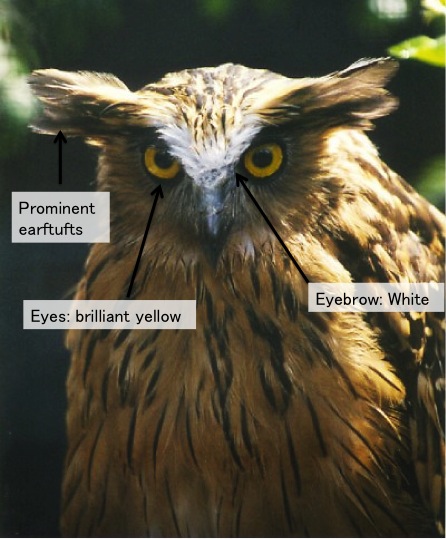 |
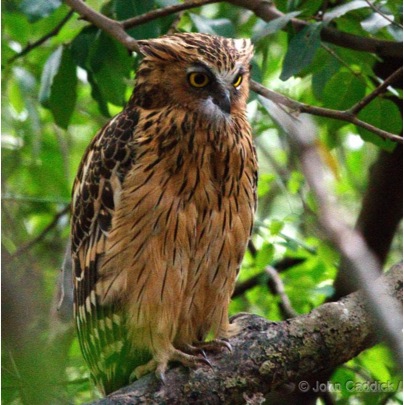 |
| Distinguishing features of Ketupa ketupu adult (Adapted from photo by: Mark Wood © within Fair Use) |
Full profile of Ketupa ketupu adult (Adapted from photo by:John Caddick© Permission granted) |
Adult and juvenile
| Adult |
Juvenile |
|
| Upper parts |
Blackish-brown; Feathers broadly margined with rufous Pale rufous or whitish spots near tips |
More rufous than in adults, Narrowly streaked with blackish-brown, Less spotted with white (or lacking white altogether) |
| Retrices |
Dark brown with whitish tips |
With 5-6 irregular narrow whitish bands |
| Under parts |
Rufous-buff or fulvous Narrow dark brown shaft-streaks, Narrower and sparser on the belly and undertail-coverts. |
Very narrowly streaked dark brown and faintly barred whitish. |
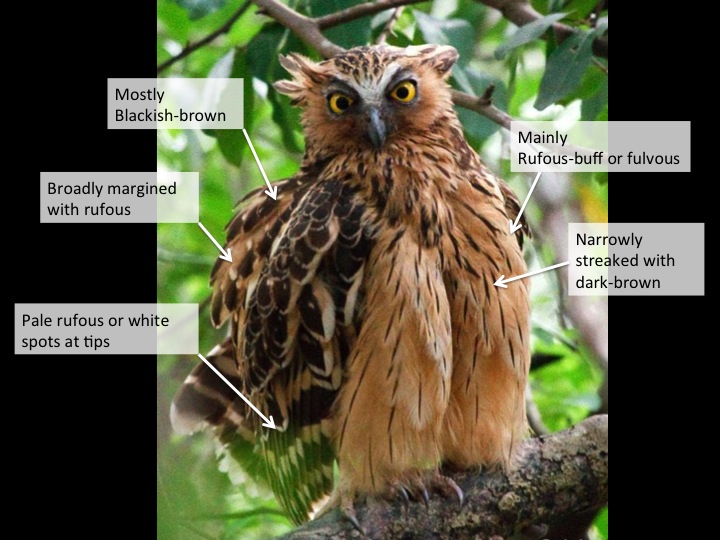 |
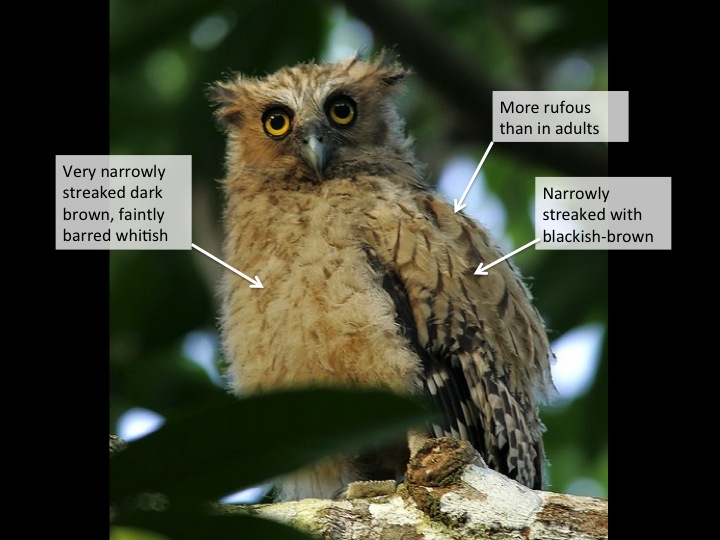 |
| Features of Ketupa ketupu adult (Adapted from photo by:John Caddick© Permission granted) |
Features of Ketupa ketupu juvenile (Adapted from photo by: Chan Yoke Meng© within Fair Use |
Diagnosis
Similar SpeciesFish-owls, or fishing owls, are generally considered to be in two genera Ketupu and Scotopelia. The genus Ketupa only consist of 4 species distributed over most of Asia, in contrast to the Scotopelia consisting of 3 species found in Africa. [10] Scotopelia (African Fish Owls) are also large and powerful. However, Scotopelia lack ear tufts, loose feathering on their heads which gives them a characteristic shaggy, maned look. [10]
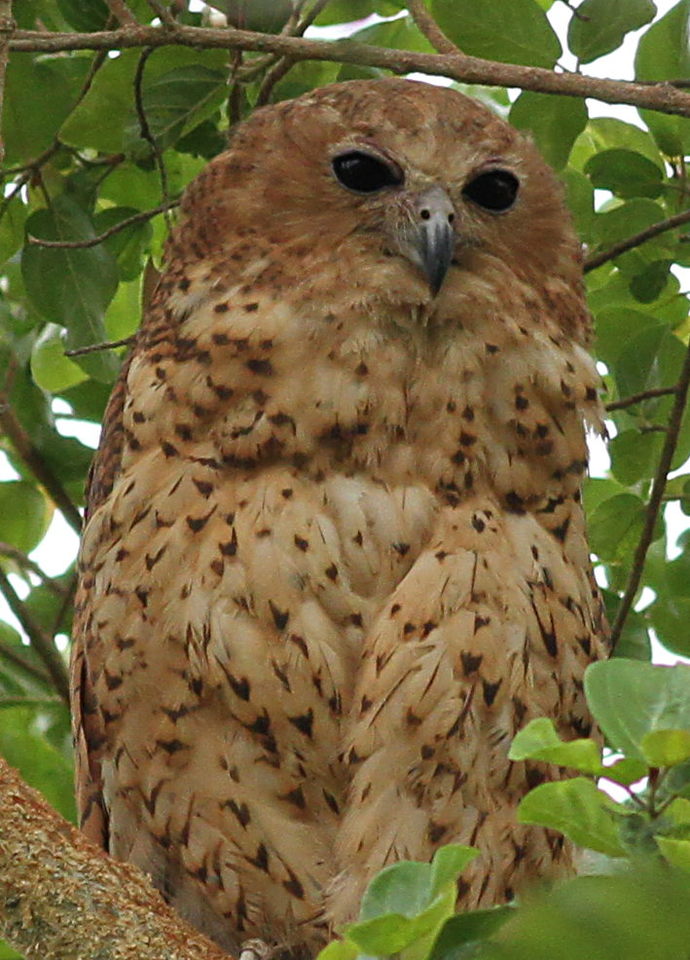 |
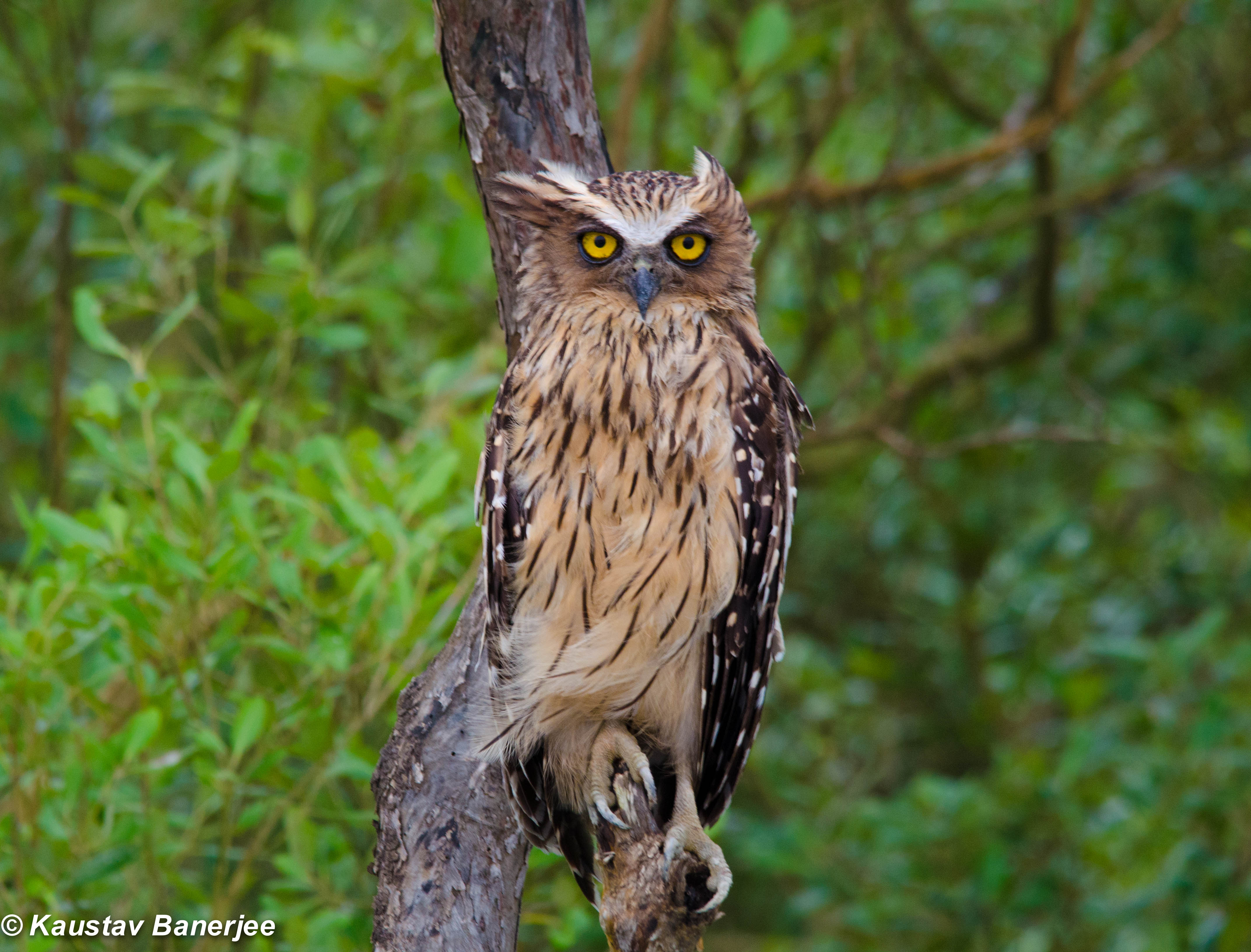 |
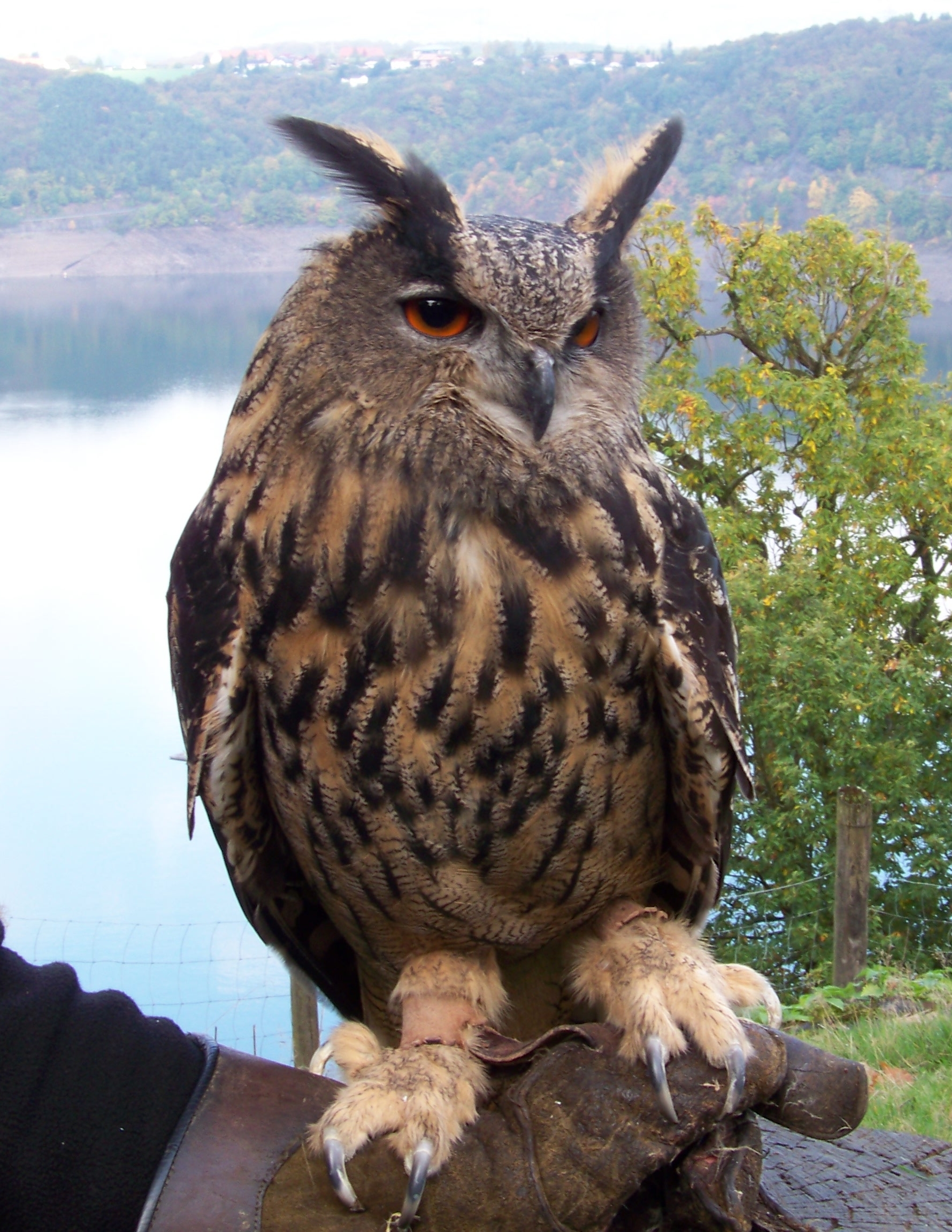 |
| Scotopelia peli; lack of ear tufts.(Photo by: Derek Keats CC BY-SA 2.0) |
Ketupa ketupu; presence of ear tufts, lack of feathers on legs. (Photo by: Kaustav Banerjee Permission granted) |
Bubo bubo; fully feathered legs.(Photo by: Stefan Didam CC BY-SA 3.0) |
(1) Feet; devoid of feathers
(2) Face: less prominent facial disc
(3) Loss of soft fringes in rear edges of wings
Ketupa sp. are generally distinct in their geographical distribution, however there are certain sympatric areas in which the geographical range overlaps. Ketupa ketupu is sympatric with only two of the Ketupa species, K. zeylonensis and K. falvipes.
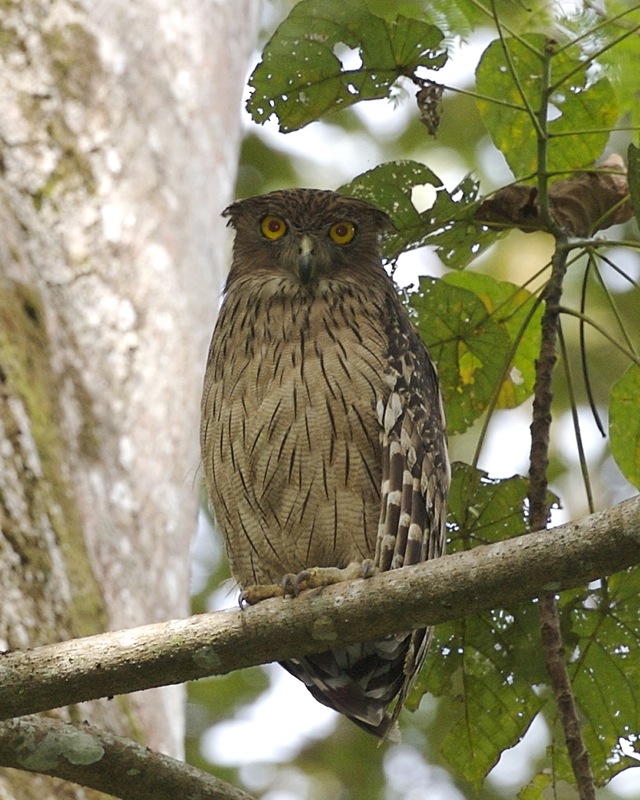 |
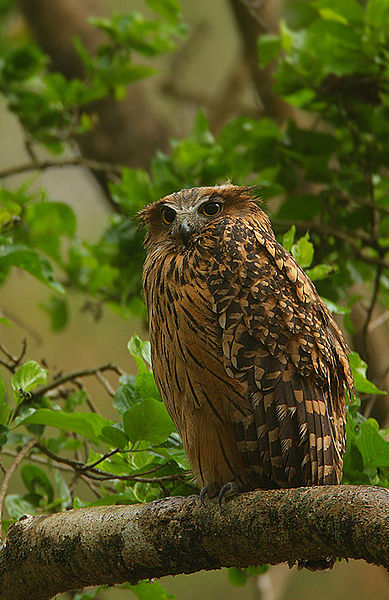 |
| Brown Fish Owl (Ketupa zeylonensis) (Photo by: Lip Lee Yap CC BY-SA 2.0) |
Tawny Fish Owl (Ketupa flavipes) (Photo by: Jayanth Sharma CC BY 3.0) |
| Some horizontal barring on underparts, as well as streaks. Larger in size. |
Rufous of underparts much richer, almost orange-rufous. Tail more narrowly barred. Face more whitish. Tarsi feathered to more than halfway down front. |
A repertoire of long drawn out shrill and wheezy notes. Hissing sounds and a rattling kutook, kutook, kutook, kutook, kutook, kutook... other vocalisations include a ringing pof-pof-pof-… and high hie-ee-ee-eek-keek notes, a musical to-whee to-whee. Also a soft monotonous and rapid pup-pup-pup-pup-pup..., utterered by a displaying pair. [8,9,11]
The female has a slightly higher voice than the male. [8]
The voice of the Buffy Fish Owl is probably the most recognizable of the four Ketupa species, being higher pitched and more musical than the other three species. [10]
| Buffy Fish Owl (Ketupa ketupu) |
|
| Tawny Fish Owl (Ketupa flavipes) |
Brown Fish Owl (Ketupa zeylonensis) |
Biology
Habitat
Usually waterside trees with dense foliage. [10]Prefers middle storey or tall trees along sluggish streams and meandering rivers through the forest or woodland, of which mango trees have been observed to be popular in the tropical areas. [10] Have been observed to be perching on the roofs of houses in rural settlements as well. [11]
Also found at a wider range of habitats near water, including mangrove swamps, beach forests, freshwater swamps or even clusters of trees nearby human-created water bodies like rice fields, fish-ponds and reservoirs and sometimes wooded sub-urban gardens [10,11]
Active Hours
Owls are nocturnal predators, active during the night and roosting in the day, in contrast to the diurnal birds of prey. Fish Owls emerge from their roosts in late afternoon on occasion, and thus they are sometimes regarded as semi-diurnal. However, they rarely hunt during those occasions, rather, they would only hunt after dusk, as with all other species that are considered thoroughly nocturnal. [10] Frequently seen flying low at dusk. [11]Roosting
Strongly territorial, tends to be evenly spaced out in the habitat.Perches singly most of the time. Can be found in a pair on the same tree, but pairs are mostly observed to be roosting in separate trees within proximate radius of each other. [10]
Usually perches with one foot on the branch and the other hidden among the body feathers. Its eyes are not necessarily closed throughout the day, it can also be half-opened or opened during roosting. Easily disturbed, often already wide awake before observer locates it. In the presence of noisy trekkers, it would become tense, with eyes wide-open and ears erect together with all the feathers around. [8,12]
Feeding
DietFeeds mainly on fish, frogs, crustaceans, reptiles (lizards) and insects.
Also: Small mammals (rats, mice); Small birds; Large insects (beetles)
Occasionally: Bats, carrion or carcass (reported feeding on a dead crocodile and remains of a badger Mydaus javanensis in Java) [8,11]
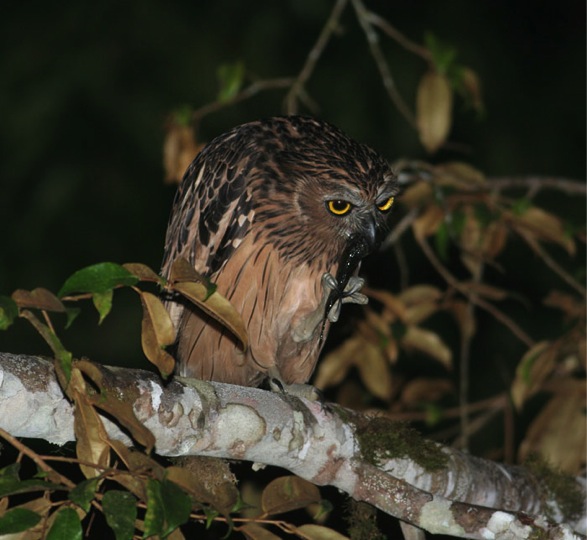 |
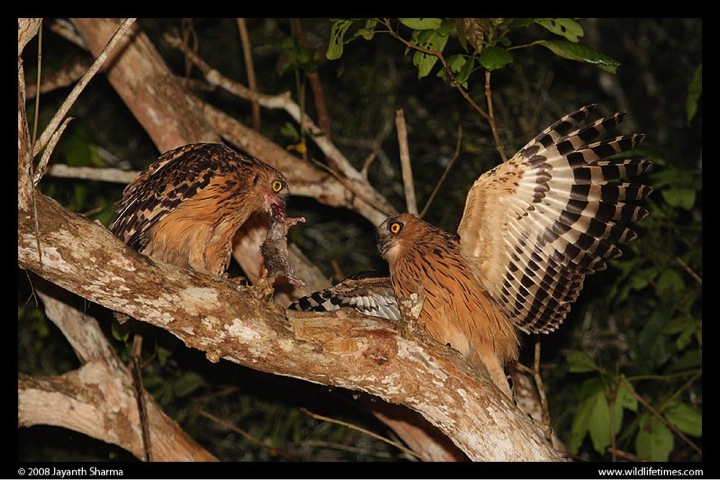 |
| Ketupa ketupu with insect in mouth (Photo by: Peter Ericsson © within Fair Use) |
A pair of Ketupa ketupu; one of them with rat in mouth (Photo by: Jayanth Sharma © Permission pending) |
They often descend to the ground, and perch at the water’s edge or from a tree on a wooded bank. They would watch and wait for their prey to swim within striking distance, then swoop in and snatch their prey from the water’s surface with their claws, unlike the bodily plunging into the water body as in the manner of an osprey. They might also wade in shallow streams, often incidentally during bathing, occasionally they would snatch crabs, frogs, fish, aquatic insects from the water. [8,9,10]
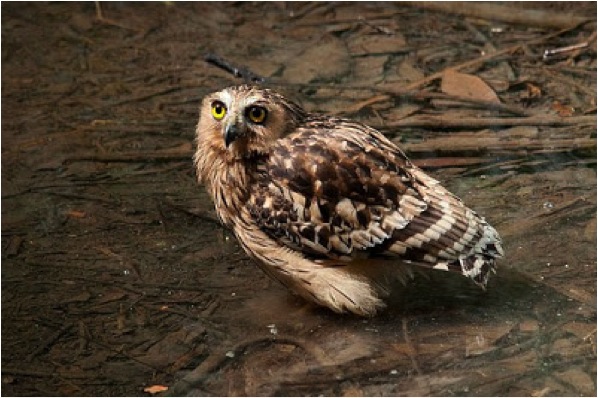 |
 |
| Ketupa ketupu in shallows; bathing or possibly feeding (Photo by: SC Lim © Permission granted) |
Ketupa ketupu poised, possibly preparing to swoop in for the kill(Photo by: SC Lim © Permission granted) |
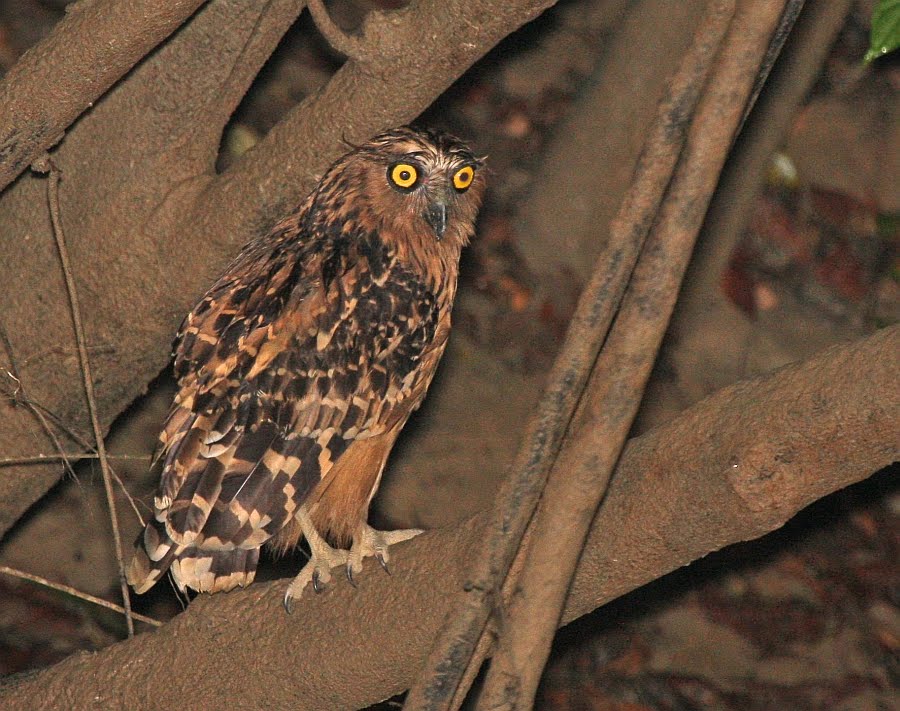 |
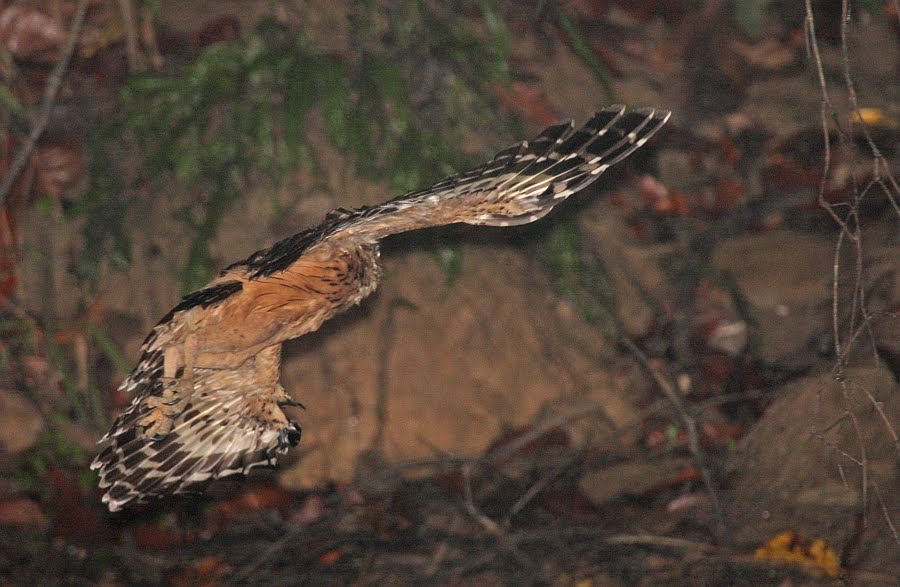 |
| Ketupa ketupu perching low, near the water (Photo by: digdeep© within Fair Use) |
Ketupa ketupu swooping in to get its prey (Photo by: digdeep© within Fair Use) |
Their feet are specialised to increase effectiveness of aquatic prey capture in three ways. [10]
(1) Lack of feathers on tarsi: Feathered legs would have been drenched and waterlogged with frequent plunging into the water for prey capture, thus the lack of feathers would optimize the capture of prey in Fish Owls.
(2) Underside of toes covered in numerous sharp edged and spiky scales: Enables them to have a good grip on the slippery and wet fish and other aquatic prey.
(3) Claws are long and curved with a sharp, lower cutting edge: Similarly gives the Fish Owl a stronger grip on its prey after capture.
owl species, that enables silent flight in owls during hunting. Presumably, this could be due to their prey being not so able to pick up airborne sounds, hence little need to conceal its presence as it swoops in to capture its prey.
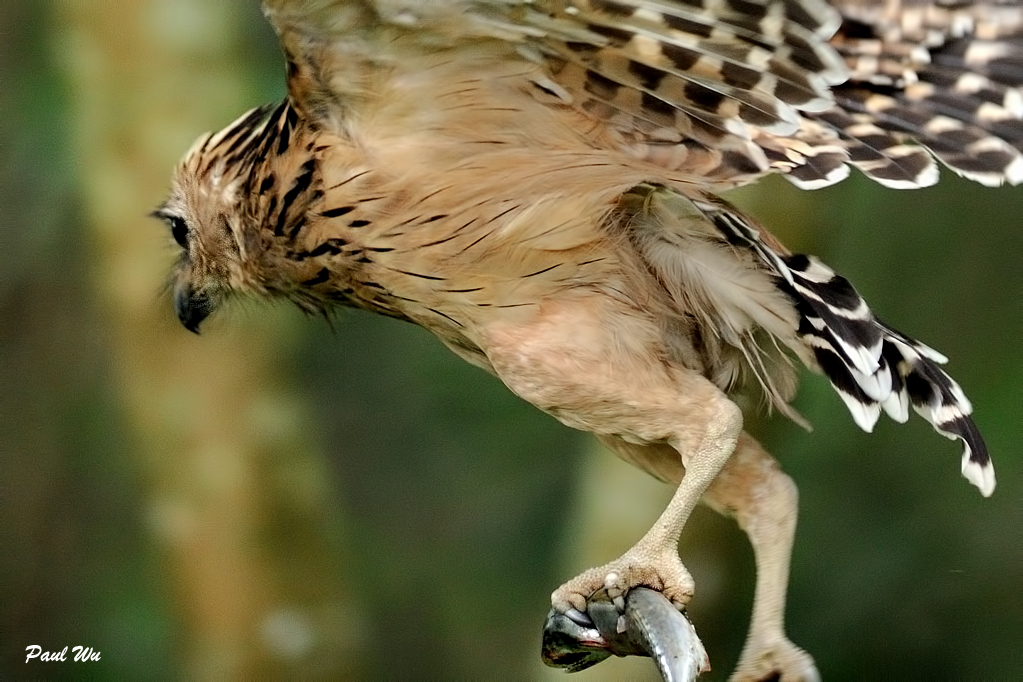 |
|
| Ketupa ketupu with fish in claws, apparent lack of feathers on legs (Photo by: Peter Wu Permission granted) |
They also have a less prominent facial disc, presumably because a heightened sense of hearing is relatively unimportant for the location of their prey, which are in a different medium. [10]
Pellets
Though pellets have been commonly observed for most nocturnal and diurnal birds of prey, this species Ketupa ketupu, does not seem to produce firm pellets or pellets of any real consistency. Instead, the undigested material such as bones, frog and insect remains are ejected in pieces and falls to the ground below the roost. Food remains never found beneath a nesting site, only in the nest. [8]
Life History
Breeding
Mainly during February to April, varies between different localities.West Java: less commonly in May to July
Malay Peninsula: less commonly in April and September to January. [8]
Both sexes are particularly noisy before breeding, and pairs participate in duet which may continue for many minutes. [9] Vocalisations usually start one month before the nesting period. [13] The male uses calls and songs to attract the female or the renew the pair-bond with its mate. Courtship feeding possibly occurs too. [13]
Females are always larger than males. (For more hypotheses on why, click here)
Nest
Does not build its own nest, instead scratches out a small depression in the centre of a bird’s-nest fern, or a humid-rich debris of decayed leaves. No special structure or lining.Frequently nests on top of bird’s-nest ferns (Asplenium nidus).
Also, in a thick bough covered by ferns, moss and orchids or tree hollows
Sometimes in old nests of raptors (e.g. Brahminy Kite Haliaster indus)
May resort to caves in rocky sites i.e. waterfalls, but rarely. [8,9]
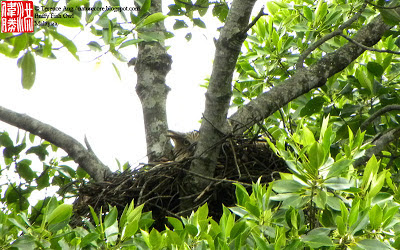 |
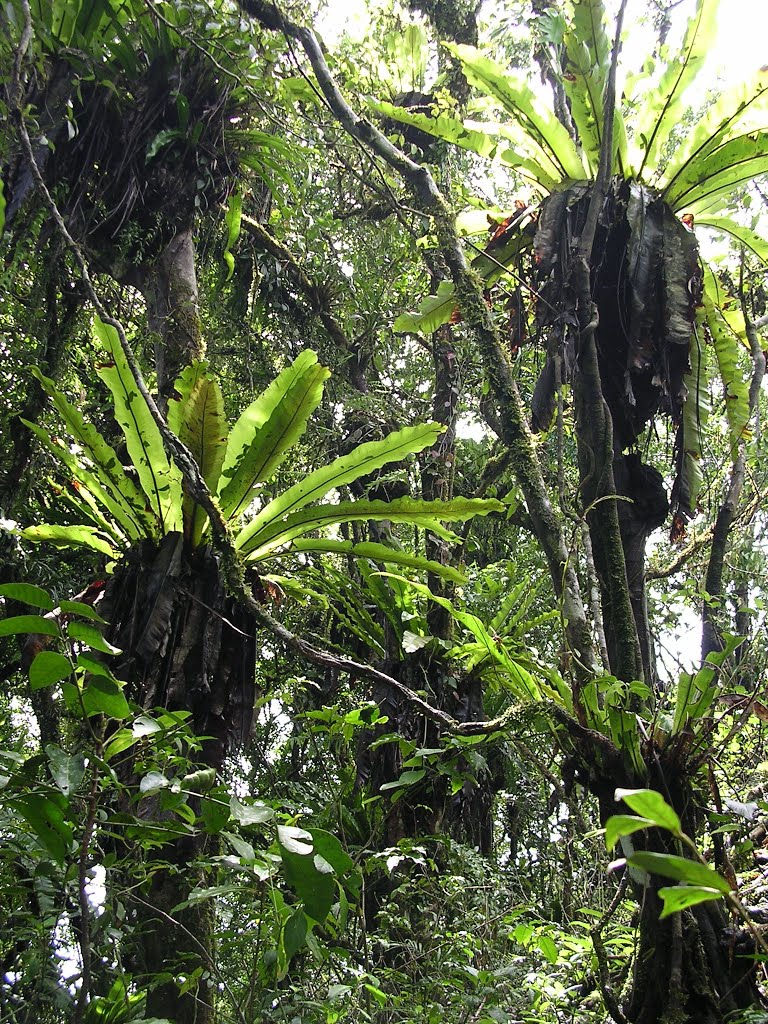 |
|
| Ketupa ketupu nesting in a Crested Serpent Eagle nest (Photo by: Terence Ang within Fair Use) |
Birds' Nest Fern commonly used in nesting of Ketupa ketupu (Photo by: Colin Trainor CC BY SA-3.0) |
Brood
Usually one, but sometimes two eggs are laid.Eggs: Broadly oval, dull white or with moderate gloss.
Egg size: 48mm x 52mm,
Incubation period: About 28-29days
In the case when two eggs are laid, generally only one chick survives
Chick will fledge after 6 weeks. [8,9]
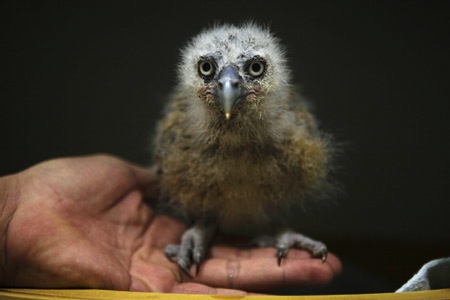 |
| Buffy Fish Owl (Ketupa ketupu) chick, in Jurong Bird Park Singapore (2008) (Photo Source: China Daily Permission pending) |
Juvenile
When faced with a threat like when approached by people or when annoyed, the juvenile has been observed to make a cup-cup-cup sound by clapping its beak. The sound might be caused by the clicking of the tongue rather than the the bill. This sound would then cause the parent to fly down close to observe what is going on. [14]Seems to be able to recognise people who do not pose a threat, as observed that the juvenile stopped its beak clapping after the observer stood there without doing anything for four hours. [14]
Has been observed to frequently yawn for long durations, holding its mouth open for 10-15 seconds at times. Presumably not just yawning but to strengthen its ‘jaws’, just as birds usually flap its wings to strengthen them as well as its body. [15]
Mortality
They have been known to live for over 30 years in captivity [9]Movement
Resident (not migratory). Exceptionally, vagrants recorded (One specimen Cocos Keeling Is., Indian Ocean, 1050km outside main range). [8]Distribution
Global
| Global distribution map of Ketupa ketupu as provided on IUCNredlist.org |
Bangladesh
Brunei Darussala
Cambodia
Indonesia: Riau Archipelago; Sumatra Island with neighbouring islands on west side (Nias etc.); Bangka, Belitung (east side of Sumatra); Java; Bali
Lao People’s democratic Republic
Malaysia: Borneo
Myanmar: South
Singapore
Thailand: South, East
Vietnam: Trung Phan (south, east); Annam (south, east)
Singapore
| Markers showing reported locations of Ketupa ketupu in Singapore |
Bukit Timah Nature Reserve: Primary and secondary forests
Central Catchment Reserve: Primary and secondary forests
Clementi Woodlands: Secondary forests [19]
Lim Chu Kang
Pasir Ris: Mangroves [20]
Sungei Buloh Wetland Reserve: Mangroves
Tuas
Pulau Ubin: abandoned rubber estates bordering aquaculture ponds
Status and Conservation
IUCN: Least Concern [16]"This species has an extremely large range, and hence does not approach the thresholds for Vulnerable under the range size criterion (Extent of Occurrence <20,000 km2 combined with a declining or fluctuating range size, habitat extent/quality, or population size and a small number of locations or severe fragmentation). The population trend appears to be stable, and hence the species does not approach the thresholds for Vulnerable under the population trend criterion (>30% decline over ten years or three generations). The population size has not been quantified, but it is not believed to approach the thresholds for Vulnerable under the population size criterion (<10,000 mature individuals with a continuing decline estimated to be >10% in ten years or three generations, or with a specified population structure). For these reasons the species is evaluated as Least Concern."
-From IUCN
CITES: Appendix II [21]
"STRIGIFORMES spp. (Except Sceloglaux albifacies and the species included in Appendix I)"
"Appendix II shall include:
(a) all species which although not necessarily now threatened with extinction may become so unless trade in specimens of such species is subject to strict regulation in order to avoid utilization incompatible with their survival; and
(b) other species which must be subject to regulation in order that trade in specimens of certain species referred to in sub-paragraph (a) of this paragraph may be brought under effective control."
-From CITES
Anthropogenic threats
PoachingThere have been several instances of Ketupa ketupu being discovered among the animals that have poached from the wild illegally and sold in the bird trade as pets. It seems that this phenomena is especially prominent in Indonesia, as the keeping birds as pets is widely popular in Indonesia and though illegal, there still persists several bird markets in many of the large cities in Indonesia like Medan in North Sumatra. [22,23]
Persecution
They might be killed due to their predation on fish and aquatic organisms, if they are seen as threats to human livelihood depending on fish stocks, especially if these Ketupa ketupu inhabit and hunt in areas near human constructs such as fish ponds.
Poisoning
In highly urbanised areas, there is commonly poisoning of rats to prevent their proliferations. However, this poses a threat to the owls as they include small mammals such as rats in the diets of these owls, and there is a risk of them being poisoned on consumption of these poisoned rats.
Loss of Habitat
Though they seem to be fairly adaptable, occupying a wide range of wooded and watery habitats [24] , in highly urbanised societies like Singapore, where there is increasingly limited areas of wooded habitats for them to inhabit, they might gradually become pushed to extinction.
External Resources
The Owl Pages: For all kinds of information about owls
Oriental Bird Images: For more photographs of Ketupa ketupu and other birds
The Internet Bird Collection : For more videos, photos and media on the Ketupa ketupu or other birds
xenocanto: For more recordings of bird calls
Bird Ecology Study Group: For more local information about birds in Singapore
References
[1] Totton, M.-L. (2003). Narrating Animals on the Screen of the World. The Art Bulletin, 85 (1), 6-24.
[2] Horsfield, Thomas (1821). Transactions of the Linnean Society of London (Trans. Linn. Soc. London) (1) 13: p141
[3] Warren R.L.M. (1999). Vol.1 Non-Passerines in Harrison C.J.O, Warren R.L.M. (1999) of Type-specimens of birds in the British Museum (Natural History) London: British Museum (Natural History).
[4] Wink, M., & Petra, H. (2000). Molecular systematics of Owls (Strigiformes) based on DNA-squences of the mitochondrial cytochrome b gene. In R. Chancellor, & B. Meyburg (Eds.), Raptors at Risk (pp. 819-828). Surrey: Hancock House Pub Ltd.
[5] Penhallurick, J. M. (2002). The taxonomy and conservation status of the owls of the world: A review. In I. Newton, R. Kavanagh, J. Olsen, & I. Taylor (Eds.), Ecology and Conservation of Owls (pp. 343-354). Canberra: CSIRO Publishing.
[6] Wink, M., Sauer-Gürth, H. & Fuchs, M. (2004). Phylogenetic relationships in Owls based on nucleotide sequences of mitochondria and nuclear marker genes. In R. Chancellor, & B. Meyburg (Eds.), Raptors Worldwide (pp. 517-526). Budapest: WWGWP and MME (Birdlife Hungary).
[7] König, C. & Weick, F. (2008). Owls of the World. London: A&C Black Publishers Ltd.
[8] König, C., Weick, F., & Becking, J.-H. (1999). Owls: A Guide to the Owls of the World. New Haven and London: Yale University Press.
[9] Lewis, D. (2013, June 19). Buffy Fish Owl - Bubo ketupu - Information, Pictures, Sounds. Retrieved November 9, 2014, from The Owl Pages
[10] Burton, P., Fogden, M., Ginn, H., Glue, D., Harrison, C., Hekstra, G., et al. (1973). Owls of the World. (J. A. Burton, Ed.) New York: E.P. Dutton &Co., Inc.
[11] Jeyarajasingam, A. (2012). A Field Guide to The Birds of Peninsular Malaysia and Singapore. New York: Oxford University Press
[12] “Portrait of an Owl: Buffy Fish Owl” by Melinda Tan, YC. Bird Ecology Study Group, 11 March 2007. URL: http://www.besgroup.org/2007/03/11/portrait-of-an-owl-buffy-fish-owl/ (accessed on 9 November 2014).
[13] “Buffy Fish-Owl” by Nicole. oiseaux-birds.com. URL:http://www.oiseaux-birds.com/card-buffy-fish-owl.html (accessed on 9 November 2014).
[14] “Buffy Fish Owl Encounters” by Allan Teo. Bird Ecology Study Group, 31 May 2007. URL:http://www.besgroup.org/2007/05/31/buffy-fish-owl-encounters/ (accessed on 9 November 2014).
[15] “Buffy Fish Owl – The Big Yawn” by Connie Khoo. Bird Ecology Study Group, 1 August 2006. URL: http://www.besgroup.org/2006/08/01/buffy-fish-owl-the-big-yawn/ (accessed on 9 November 2014).
[16] Bird Life International. (2012). Ketupa ketupu (Buffy Fish-owl, Buffy Fish Owl, Buffy Fish-Owl). The IUCN Red List of Threatened Species URL: http://www.iucnredlist.org/details/full/22689024/0 (accessed 9 November 2014)
[17] Lee Kong Chian Natural History Museum. (2011, November 15). Ketupa ketupu. Retrieved November 9, 2014, from The Digital Nature Archive of Singapore: http://137.132.71.21/dna/organisms/details/894
[18] Ho, H. C. (1997, Jan-Mar). Close Encounters with Owls of Singapore. Nature Watch , 5 (1).
[19] The Nature Society Singapore. (2011). The Green Corridor: A Proposal to Keep the Railway Lands as a Continous Green Corridor. Singapore.
[20] “Buffy at Pasir Ris” by Ria Tan. Wild shores of Singapore, 20 April 2013. URL: http://wildshores.blogspot.sg/2013/04/buffy-at-pasir-ris.html#.VF9lz0vjsgk (accessed on 9 November 2014).
[21] United Nations Environment Program (1973). Appendices. Convention on International Trade in Endangered Species of Wild Flora and Fauna URL: http://www.cites.org/eng/app/appendices.php (accessed 9 November 2014)
[22] Shepherd, C.R. (2006). The bird trade in Meda, north Sumatra: an overview. Birding Asia, 16-24)’
[23] Shepherd, C.R. (2012). The owl trade in Jakarta, Indonesia: a spot check on the largest bird markets. Birding Asia (58-59)’
[24] del Hoyo, J., Elliot, A. & Sargatal, J. eds. (2012). A Field Guide to The Birds of Peninsular Malaysia and Singapore. New York: Oxford University Press